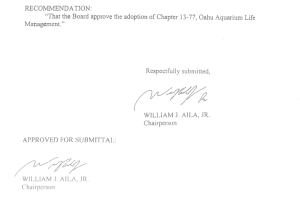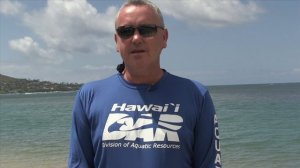
The Submittal for the O’ahu Rules Package Lacking McGilvray’s Signature — DAR Administrator’s signature usually appears above right, but Chairperson Aila signed this submittal twice.
When a submittal for approval of an O’ahu aquarium fishery rules package on today’s Board of Land and Natural Resources (BLNR) meeting agenda lacked the signature of the Hawaii Division of Aquatic Resources (DAR) Administrator Frazer McGilvray, those who have followed the State’s contentious aquarium fishery had an inkling that something was up. Of the four submittals from DAR on today’s agenda, the other three are signed, as usual, by DAR Administrator McGilvray and then approved for submittal by the BLNR Chairperson, William Aila. The O’ahu rules package submittal, however, is signed twice by Aila, raising suspicions that appear to be later confirmed when McGilvray announced his resignation to DAR staff this morning via email. Once again, DAR finds itself leaderless at a time when many political uncertainties exist in Honolulu and when the reefs and reef life DAR is charged with protecting and restoring are increasingly at risk.
Proposed O’ahu Aquarium Fishery Rules
The submittal lacking McGilvray’s signature concerns proposed administrative rules for the O’ahu aquarium fishery. According to the submittal, the new rules were proposed by the fishers because the fishers “recognized the need for better management of the fishery to reduce the potential for waste of limited resources and to implement conservation measures that would ensure the long-term economic viability of the fishery.” The proposed rules include regulations on net size, bag limits on specific fish species, and a ban on collecting three species. Approval by the Board today is the final step before the rules package would go to the Governor’s desk to be signed into law.
While McGilvray has not spoken out publicly concerning the proposed rules, sources close to the situation have indicated that DAR’s administrator felt conflicted about supporting it. Ultimately, he refused to sign it, and while this was not the only issue leading to McGilvray’s resignation, it has been characterized as “the straw that broke the camel’s back.” Neither McGilvray nor public relations officers from the Hawaii Department of Land and Natural Resources (DLNR) responded to requests for comment prior to publication.
Concerns about Utility of Rules
It’s not a huge secret that DAR biologists and McGilvray had severe concerns about the utility of these rules. As one person familiar with Hawaii’s aquarium fishery and the rulemaking process said in a background interview for a feature story on which I’m working:
The rules as I read them sounded good to those not much in the know about these things, but in fact, did nothing at all in terms of limiting or managing the aquarium take on O’ahu. No closed areas, ridiculously high bag limits, etc. It was lip service so that the collectors there would gain some credibility, be able to tell Snorkel Bob [aka Robert Wintner] and Rene [Umberger] that they are being “responsibly managed,” too. But they were not.
Specifically, some have expressed concerns that the bag limits in the prosed rules are not based on science nor stock data and are set way above the current daily aquarium catch. If aquarium fishers were to take the proposed bag limits, critics contend, the actual total catch could skyrocket compared to what it is. Nobody familiar with the way the fishery works has suggested a “skyrocketing” aquarium catch is a real risk because the fishery is relatively small in size, the complexities involved with harvesting many of the species in question tend to limit the take, and other proposed regulations concerning net size would make it difficult to greatly increase the harvest. DAR and other independent scientists say they have no scientific information indicating that marine species taken in the O’ahu aquarium fishery are being overfished or that overfishing is occurring.
Internal Conflict
McGilvray is a respected scientist, and, since his appointment, a common narrative amongst detractors of DLNR has been that Chairman Aila feels “on the defensive” or “threatened” by McGilvray’s credentials. When it comes to the aquarium fishery, there is a perception that Aila, who once held an aquarium fishery permit, is biased toward the fishers. As well-known anti-aquarium trade activist Robert Wintner said during a December 2012 public hearing regarding the proposed O’ahu rules package:
Hawaii reefs are in decline, yet William Aila’s orchestration of aquarium trade entrenchment in Hawaii continues with these “rules packages.” Aquarium collectors and wholesalers wrote these rules, and after these so-called “hearings” to ventilate public outrage, aquarium collector Aila will pass these rules with unanimous consent.
Even some of those who don’t share Wintner’s vitriol for the aquarium fishery–people who support a sustainable, well-regulated aquarium fishery in Hawaii–have expressed concerns about Aila’s leadership when it comes to data-based fishery management.
“Months of tension between [McGilvray and Aila] came to a head over this rules package,” speculates one source. “Clearly McGilvray wouldn’t support it and wouldn’t sign it and Aila overrode him. It’s not surprising he quit.”
“A Huge Loss for Hawaii”
Aila aside, many who know McGilvray says his resignation from DAR will be a major set-back for Hawaii. When hearing the news of his resignation today, some expressed anger that he didn’t “dig in his heels” more or fight more aggressively, but overall, they express both sadness and concern for Hawaii.
“Frazer McGilvray was uniquely qualified to lead DAR, so this is a huge loss for Hawaii,” says Brian Tissot, Director of Humboldt State University’s Marine Laboratory and co-author with McGilvray on several papers. “His extensive background and experience in tropical marine ecosystem with the Marine Stewardship Council and Conservation International provided him with the tools to both understand the science behind the issues facing Hawaii’s marine resources but also to articulate the policies to solve ongoing problems.”
A Red Herring
For their part, the O’ahu aquarium fishers, the ones who came up with the rules in the first place, say the concerns about bag limits are little more than a red herring. “They were not intended to limit the overall catch and could never be effective at doing so,” says O’ahu aquarium fisher Matthew Ross. “Those numbers were chosen because they’re what we feel a small boat can carry…without being overcrowded. The purpose of the limits is to promote animal welfare, which has nothing to do with how many fish come out of the ocean.”
Ross maintains the bag limits are not something that needs to be determined scientifically. “The fishery has been sustainable for 40 years now without bag limits in place, and putting a number on things won’t magically make us catch more fish.”
Several of the O’ahu fishers point out that the bag limits were contentious even amongst the fishers. Most agree the net limit followed by the size limits for kole and yellow tang are the most important components of the proposed rules from a conservation standpoint.
This article was updated at 5:15 est on Saturday 25 October to include an additional quotation. The rules package did pass and McGilvray reportedly submitted testimony against the rules package as a private citizen. Some advocates of the rules package portrayed McGilvray as “being in cahoots with Umberger” and the anti-trade activists. More to come here at the Good Catch Blog as the situation plays out…


Pingback: New O'ahu Aquarium Fishery Rules Approved